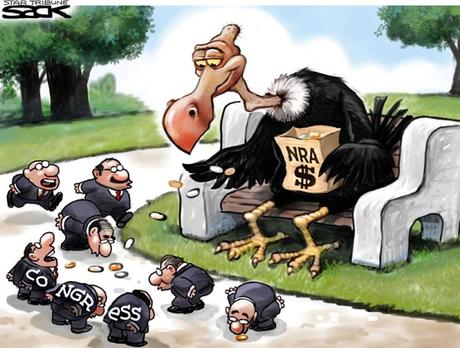 (Cartoon image is by Steve Sack in the Minneapolis Star-Tribune.)
(Cartoon image is by Steve Sack in the Minneapolis Star-Tribune.)For years now, the NRA has preached that the solution to gun violence is to let more Americans carry guns. It's a silly and dangerous idea, and it's a lie. Now there is proof that more guns means a more dangerous society. Consider this great article by Amanda Marcotte at Salon.com (much of which is posted below):
One of the most contentious arguments within the larger gun control debate is over whether right-to-carry laws that make it legal for gun owners to carry loaded weapons in public, usually concealed on their person, make people safer. Gun rights advocates argue that packing heat is a prevention against crime and violence, invoking slogans like, "An armed society is a polite society." Gun control proponents, however, argue that a proliferation of loaded weapons is bound to lead to more violence, if only because people have easier access to the means to harm others. John Donohue, a legal researcher who works for Stanford Law School, has been working on this question for the better part of two decades. "Turns out it’s a tricky question to answer through statistical means," he told Salon. But now "this data [has] become complete enough, and some of the new statistical techniques have been implemented," he continued. The correlation between the passage of right-to-carry or RTC laws and violent crime has long been documented, Donohue explained, but as anyone with even the most basic knowledge of statistics understands, correlation is not causation. Now, with a combination of sophisticated statistical analysis techniques, Donohue and his team believe they have been able to document a causal relationship. "Ten years after the adoption of RTC laws, violent crime is estimated to be 13-15 percent higher than it would have been without the RTC law," explains the paper, published at the National Bureau of Economic Research. There are a number of different reasons why violence has apparently increased under right-to-carry laws, which is why the negative effects of these laws tend to be compounded over time. “The most obvious problem is people get into disputes that, without guns, would at the most lead to a bloody nose," Donohue explained. If one or both parties are carrying guns, such conflicts "can now lead to death." . . . While impulsive violence is an issue, Donohue said, perhaps the bigger problem is that "when you start carrying guns, you make them much more likely to be stolen," which means that right-to-carry laws offer a steady supply of guns to people who are already inclined to commit crimes. "American gun owners, preoccupied with self-defense, are inadvertently arming the very criminals they fear," explained Brian Freskos at The Trace, kicking off his November investigative report on the way stolen guns have become a major component of the gun crime problem. More than 237,000 guns were stolen from legal gun owners in 2016 alone, though Freskos believes that is a drastic underestimate, as many gun owners never report thefts to the police. One reason gun theft is so common is because right-to-carry laws and NRA propaganda encourage gun owners to have their firearms accessible at all times: in their cars, in their homes or on their person. If people kept guns locked up (as responsible firearms owners did for generations), this problem largely wouldn't exist. But when guns are on coffee tables, in glove compartments or carried in holsters, they become easy targets for thieves. Reliable estimates suggest as many as 3.5 million stolen guns have entered the black market over the past decade. The gun industry profits from all those stolen guns, since many people who have a gun stolen are back in the store the next day, buying a replacement. So the NRA has every incentive to encourage people to carry guns or otherwise store them in places there they can easily be stolen. That ends up boosting profits for manufacturers, whom the NRA represents first and foremost. . . . The reality is that carrying guns may make people feel safer, but all the available evidence suggests that it makes society less safe. Having guns everywhere makes lethal violence more likely, and also has a psychological effect, making it seem more socially acceptable — desirable, even — to resolve conflicts with violence instead of diplomacy.

